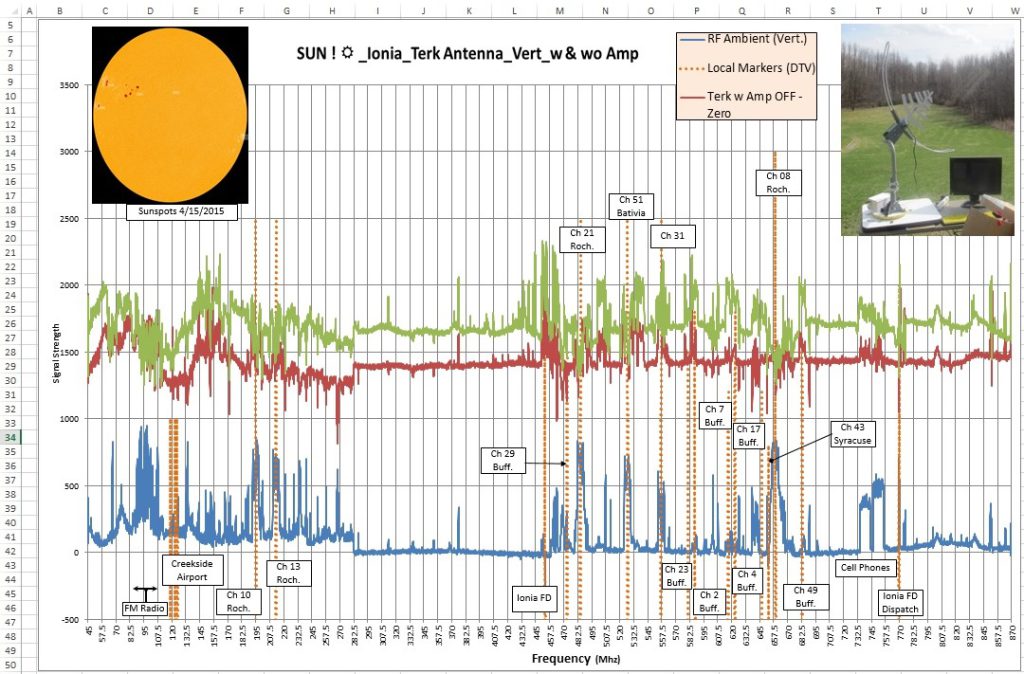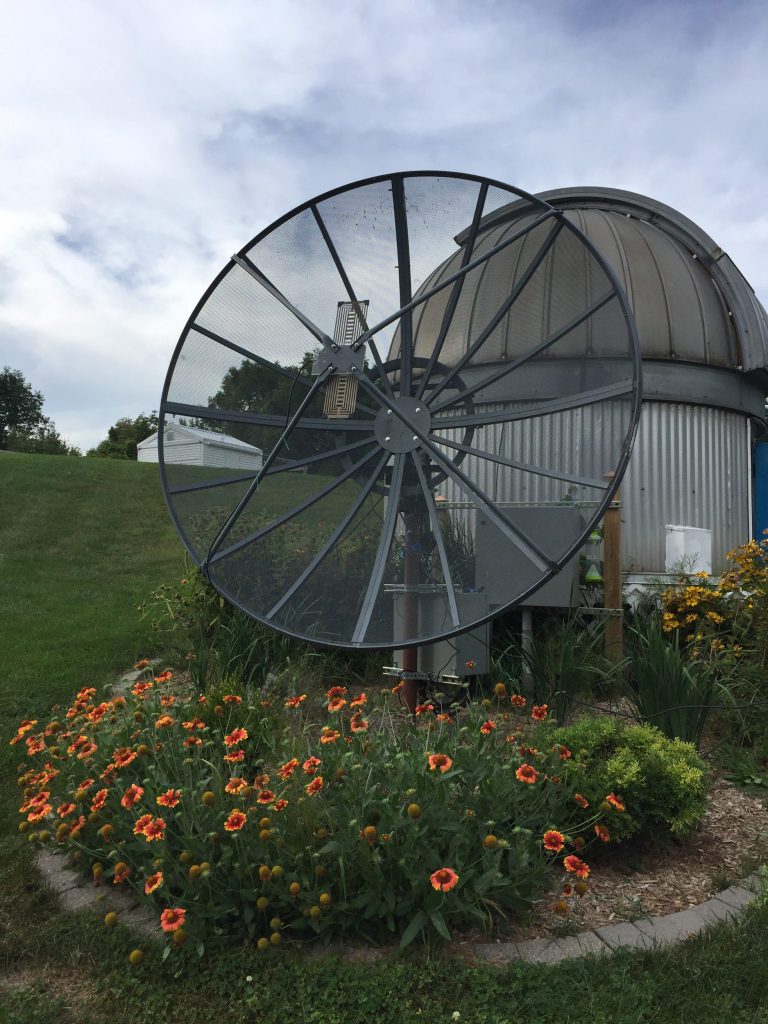Callisto Solar Radio Spectrometer Development in Western New York, USA
Preface
Over the years, I’ve read with great interest the many RaRa projects in the club’s newsletter. I hope you find our work below, an acceptable, addition, to this excellent collection. This radio telescope is being developed for the global e-Callisto solar telescope network.
Intro – The School & Program
Rochester Institute of Technology (RIT) is an internationally known Engineering and Technology college, based in Rochester, New York USA starting in 1829. In addition to traditional university departments, it is renowned for its cutting-edge technology development programs. The Multi-Disciplinary Senior Design (MSD) Program, part of the Kate Gleason College of Engineering, is meant to mimic real life (industrial environments) by exposing senior students to a team approach to project and process development. In doing so, student transition into the workforce is almost seamless. The project below has been developed under this umbrella.
Project ART
Our development of a Solar Radio Telescope to study Sunspots began as an alternative to optical telescope observations, given the local WNY weather. We are in one of the cloudiest sections of the country due to the Great Lakes being just to our west (windward), so the number of clear observing days is very limited. The fact that clouds are transparent to radio waves, made a radio telescope a natural observing solution.
There was a desire to make a fully Autonomous Radio Telescope system to study the Sun, including pointing and tracking, data collection, analysis, and information transfer (to Zurich, SZ). By anyone’s standards, this is quite an undertaking in the professional world, let alone a student driven one. A means to breakdown critical functions into digestible pieces (modules) had to be developed, for a new student team to tackle every school year.
The first few years were spent in developing ‘proof of concept’ ideas for basic functions. This part was one of frequent frustration and dead ends. Ideas that seemed (theoretically) logical just didn’t pan out with real world data. Example, most Callisto systems use a standard Log Periodic ‘Yagi’ like design. In our location, however, a strong local TV station swamped the rear lobe of our LP design. Thus, the development of a modified feed, 7’ (2M) dish, for its superior front to back ratio. The next few years saw many system partitioning ‘paper’ concepts of basic functions. Finally, we settled on prioritizing the most difficult functions first.
By far, we viewed the autonomous tracking feature the most difficult function to automate. Waking the system up in the morning, pointing to the east and acquiring the Sun was the starting point. Tracking during the entire day, until Sunset was the goal, without needing any (local) human operator intervention. The location (Ionia, NY) is rather remote to the Rochester city center (away from noise & interference sources), and, almost an hour from the RIT campus. The logistics ruled out productive daily and weekly visits by the student teams to work on the system, especially since there are no appropriate labs, test equipment or model shops nearby. Further, imagine the challenge of having to dis-assemble the entire system and transporting it back to campus each new school year, for the incoming development team, a very time consuming and slow process.
The first senior development team P15571 was tasked with this mission critical, tracking function. An RA / Dec mount was designed, built on campus, and demonstrated. It was then installed in Ionia to enable basic (manual) operation. This accomplishment enabled some local data taking during the summer, to further our understanding of the local ambient noise, and allow taking basic Solar data. This effort, along with a totally manual ’proof of concept’ portable bench set-up is shown below.

The bottom (Blue) trace shows the local interference (FM radio, TV stations, a cell phone tower, etc.). The two upper traces (Red wo an amplifier, Green w an amplifier) show the actual Sun signal with the bottom (blue) trace mathematically removed. Note the very large Ch 8 TV signal (@ ~ 658 MHz) removed from the two processed Sun data sets. It is possible to change the individual gain coefficients on each slice of the data to make the local noise essentially ‘disappear’. A visual SOHO image of the Sun at the time (w sunspots), is shown in the upper left, and the portable test setup in the upper right. The ‘local noise’ (blue) trace data, was taken with a vertical dipole.
The second design team P17571 concentrated on controls and software development. Our initial effort was to try to use Radio Eyes software to add the systems intelligence to our project. This software is like a (visual) Planetarium software program (Stellarium, etc.) but for what’s ‘visible’ in the RF radio sky.
The third design team P18571 consisted of fleshing out the controls, adding an uninterruptable power supply (UPS) to minimize system crashes and data corruption, improving software operability and looking into the possibility of nighttime operation by adding low noise amplifiers (LNAs). The UPS was not designed for continuous operation in the event of a power loss, but a means to provide a ‘soft landing’ so that ‘in process’ data files could be saved, systems could be shutdown in an orderly sequence, etc., then restarted from a known good state (& position) when power re-appears. The LNAs are meant to try to acquire the top 40 brightest RF objects in the northern night sky, limited by the meager dish size of only 2 meters, (of all the tasks, this, is our lowest priority).
The next design team P19571 concentrated on designing a LabView like GUI (graphical interface) to look like a piece of test equipment, for operator input and controls. At this point, the system was operational enough to make preliminary data runs and to try sending preliminary data to Zurich.
The present team P20571 is concentrating on systems level integration, software, and functionality, including a web based interface ‘portal’ for remote operations. The hardware is being expanded to include dual receivers, one to collect the Sun signal, the other to collect the local interferers. The ‘local’ dipole is mounted right on the telescope mount, so it tracks with the dish and has its ‘null’ axis pointed directly at the Sun, thus minimizing the Sun signal, and maximizing the related ‘local’ RFI signal. The intent is to send the regular *.fits, *.csv files, etc. that have been the traditional Callisto formats. Maybe later the e-Callisto network will be able to expand into corrected formats compensating for the each of their local interferences, at problem Callisto stations.
The photo (below), taken this last summer, between build blocks, shows the Rochester area (Ionia, NY) installation of our Callisto station called ‘KROC’ located at [ N 42.929826, W -77.500156 ].

Our hope is that we will be ‘on the air’ by the end of this school year, May 2020.
Sincerely,
Martin J Pepe
MjpAstro@aol.com
Do you know what your Sun is doing today ? ART does!
Credits
Recognition and credit(s) have to be given to those supporting this effort. Funding & (remote) site location in Ionia, NY was provided under an ‘educational outreach grant’ by the Astronomy Section of the Rochester Academy of Science (ASRAS). Site selection and characterization was performed by students from the University of Rochester (U of R). Development and Lab facilities were provided by RIT Kate Gleason College of Engineering.
Besides the direct involvement of the mainline student teams, additional thanks, has to be given to the many students, professors and support personnel who have given us their continued support over the (many) years of its incubation, and development.
Cloudy Skies ? – Switch to a longer wavelength!
Original posting: 3 March 2020 by Pete Bonneau
Original location: rochesterastronomy.org/art-autonomous-radio-telescope/